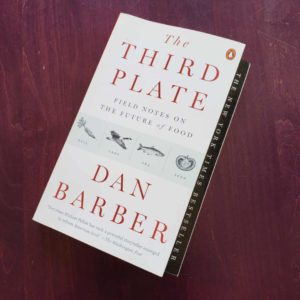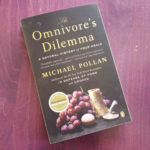TLDR:
Check out these two TED talks by Dan Barber. These two stories are told in The Third Plate, along with dozens more. If you like those TED talks, you’ll like this book. In reading the Third Plate you will learn a lot about what’s wrong with modern food systems, but you’ll also get to meet many interesting people who are doing things radically different and for the better.
Dan Barber: How I Fell in Love with a Fish
Dan Barber: A Surprising Parable of Foie Gras
The Three Plates
Dan Barber came up with the concept of the “third plate” early in his career as a farm to table chef. One evening he had lamb chops on the menu. They were sourced from a local farmer with whom Dan had developed a relationship. They sold out in the first hour of service. That experience led him to understand that he was serving in the “second plate” style. The “first plate” is what America has become accustomed to over the last few decades. The dinner plate is focused on a large portion of protein with vegetables and starches playing supporting roles. This type of plate has become affordable, even cheap, due to industrial agriculture practices. But those industrial agricultural practices have their hidden costs as soil degrades and erodes, their carbon footprint explodes, and the general health of the US population plummets. The plates he was serving looked just like the first plate, replacing the components with local and organic options. Sure, this meant that food miles were decreased, and he was supporting organic agriculture, but he wasn’t really moving the goalposts. He cherry picked the most prime cut of the lamb, leaving the farmer to figure out how to sell the rest of the lamb. For produce, he only purchased the most popular options. As such, he was telling the farmers what to produce, instead of letting the farmers do what was best for sustainability and regeneration of the farm. Dan then envisioned the “third plate”. On this plate, vegetables take the center stage and animal proteins take on the supporting role. The vegetables are those which the farmer has chosen to grow. The farmer not only chooses what is nutritious and delicious, but also what leads to long term farm and soil health.
Impact
Dan Barber’s Third Plate had a huge impact on me personally. I listened to the audiobook version, read by Dan himself, on a long, solitary car ride. At the time I was struggling with satisfaction in my chosen career. There is some chef memoir going on in this book, and chef’s memoirs are a guilty pleasure of mine. But what really worked for me was all the people that you are introduced to throughout the book. These are people involved in food production and culinary work who are trying to do things differently. They are trying to do the right thing either by going back to traditions of the past or going forward with technology, or a blending of both. As I listened to the narration, as the work of each of these people is described, I’d think to myself, “I’d rather be doing that than my current job!”
The following is not a complete list of people that you will meet as you read this book, but I think it makes the point:
- Jack Algiere, who runs the farms at the Stone Barns Center for Food and Agriculture. That’s where Dan Barber has his Blue Hill at Stone Barns restaurant. Jack appears early and often in the book. One anecdote is how Jack was happy to grow an heirloom variety of sweet corn. He did so using the 3 sisters method traditionally used by the Iroquois Indians. The corn was planted in mounds with beans and squash. The beans are a legume and fix nitrogen in the soil, which feeds the other plants. The corn grows tall, providing a natural trellis for the beans to climb on. The squash provides shade for the roots of the taller plants and suppresses weeds.
- Klaas and Mary-Howell Martens who are grain farmers on a large farm, I believe 1,400 acres. While large, Klaas manages to keep in sensory touch with all his fields. “If your farm becomes so large that you can’t identify the different grasses and know what they are telling you about soil health, you’re not farming…” The Martens are particular about growing food. That is, growing things that feed people around them. Explicitly not growing field corn which is used to feed animals and to manufacture starches, sweeteners, and corn oil.
- Wes Jackson, a scientist devoted to the commercialization of perennial wheat varieties. Perennial wheat varieties have root systems that extend deeper below the ground than their stalks extend above the ground. This makes them drought tolerant and able to retrieve nutrients from deep underground. Tilling and fertilization are not required and the soil they grow in is alive with vibrant microecological communities.
- Miguel Medialdea who manages the Veta La Palma fish farm in Spain. The farm works with nature, not against it. Besides being a fish farm, it is credited as being the largest private bird sanctuary in Spain. Huge flocks of flamingoes travel 150 miles every day to feed at Veta La Palma. The birds consume a huge proportion of the farm’s production, but harvests are still large and the quality is high. The ecosystem of the farm acts as a pollution filter for water heading out to sea.
- Eduardo Sousa who produces humane foie gras on his farm in Extremadura, Spain. Foie gras is traditionally produced by force feeding grain to ducks or geese causing their body to react and produce very enlarged livers. Eduardo does none of that. He pampers his geese, letting them run freely and eat acorns and other food options that Eduardo has cultivated on his land. “If you make sure the geese are relaxed and happy, you’ll be rewarded with the gift of fatty livers. That is God’s way of thanking us for providing so much good food for the geese.”
- Placido and Rodrigo Cárdeno who raise Iberian pigs and produce jamón ibérico in a region of Spain called the Dehesa. The quality of this ham is world renowned. It’s not just the Iberian pig breed or a diet rich in acorns. It is the ecosystem which has been preserved for centuries. Large expanses of pasture dotted with mature oak trees. After foraging under an oak tree, the pigs must travel to the next tree on the horizon. As such, they are well exercised, and their diet is made more complex due to foraging in the pasture between trees.
- Ángel León, a chef in Spain who is so dedicated to the sea that he refused to have bread in his restaurant until he developed a recipe which incorporated phytoplankton so that the bread tasted of the sea. He makes avid use of lesser-known fishes, often lower on the food chain, whose populations are not hit as hard as the most popular fish varieties. And he uses the whole fish, down to the eyeballs, which he purees to thicken sauces.
- Bruce, Margaret, Courtney, Walter, and Michael who are plant breeders at Cornell University. They are thrilled with the idea of selecting for flavor and nutrition. Modern industrial practices have forced plant breeders to select for yield, uniformity, packability, and shelf life.
- Glen Roberts who runs Anson Mills and is dedicated to the revival of heirloom grain and legume varieties that were traditional in the Carolina’s and Georgia in the 19th century. There was a time when flavor was the driving factor in selection of varieties. These varieties had been on the brink of extinction, pressured off the market by modern varieties.
- Stephen Jones, the director of the Washing State University Bread Lab. The bread lab brings together farmers, chefs, bakers, and breeders to freely experiment and collaborate with new wheat varieties.


